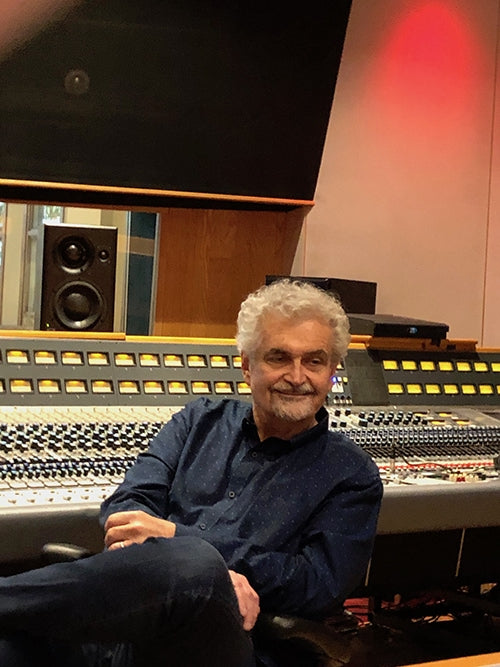The 1970s was a landmark era for both technological and artistic breakthroughs in the field of music recording. The 8-track recorder had just given way to 16-track models, transistor technology was coming into its own as a sonically viable alternative to tube technology for microphones, consoles and outboard gear, and new artists were emerging who saw greater creative possibilities for multi-track recording beyond what the Beatles had pioneered with their 1967 Sgt. Pepper’s Lonely Hearts Club Band album.
With a combination of musical talent, incredible ears, a yeoman-like work ethic and an uncompromising drive towards excellence, multiple Grammy Award-winning engineer Bill Schnee serendipitously took a moribund career playing keyboards and parlayed it into becoming one of the top engineers and producers in the music industry. A partial list of artists whose records he engineered (and sometimes also produced) can be found in the record collections of practically any popular music fan born prior to 1990:
| Whitney Houston The Beatles Michael Jackson and the Jacksons Steely Dan Boz Skaggs Marvin Gaye Toto Barbra Streisand |
George Benson Natalie Cole Carly Simon Chicago Miles Davis The Pointer Sisters Dire Straits Neil Diamond |
Schnee’s autobiographical memoir, Chairman at the Board: Recording the Soundtrack of a Generation, is a fascinating insight into the challenges, missteps, battles and victories undertaken to create such memorable recordings as Steely Dan’s Aja, Carly Simon’s “You’re So Vain” and No Secrets LP, Whitney Houston’s “Greatest Love Of All” and self-titled debut album, and perhaps the only true Beatles reunion record: the Richard Perry produced Ringo, in which Schnee was able to record Ringo Starr, George Harrison and John Lennon together, later flying to England for Paul McCartney’s contributions, as the latter was at the time barred from entering the US over a previous marijuana bust.
Additionally, the book has a special treat for audiophile Copper readers who may be aware of Bill Schnee’s pioneering work with Sheffield Lab Records. Sheffield launched the first audiophile targeted direct-to-disc recordings, including Schnee’s production and engineering of Thelma Houston’s Grammy-nominated I’ve Got The Music In Me, as well as Lincoln Mayorga’s Distinguished Colleagues records. The book goes into minute detail on the pressures of recording a large ensemble with horns, live in the studio without overdubs or post-production mixing, essentially creating an audiophile-level version of how recordings were initially performed on Thomas Edison’s wax cylinder recorder nearly a century earlier.
Ironically, the song “Pressure Cooker” from I’ve Got The Music In Me became a sample backing track for “Pressure,” a 2006 rap record by Lupe Fiasco and Jay-Z that was itself subsequently nominated for three Grammys, including Best Rap Album.
Some of the anecdotes debunk rock legends. For example, Steely Dan, known for taking painstakingly long to make their records, was surprisingly efficient when Schnee recorded Aja, which earned him a Grammy engineering award. The album is frequently used by many producers as a reference disc for checking monitors in an unfamiliar studio, due to the record’s famously pristine sound. While many a studio musician has spun horror tales of having to do countless takes in the quest for the sonic realization of Donald Fagen and Walter Becker’s musical visions, Schnee recalls the Aja sessions as being relaxed and professional, starting promptly in the afternoon and ending by early evening. In the meantime, he would take cassettes of rough mixes with him on his drive home, fascinated by the amalgam of jazz, rock, pop and blues that would make Aja eventually a perennial Top 100 music critic album favorite.

Bill Schnee. Courtesy of Sallie Schnee.
Perhaps due to his own experiences as a musician and in working with producers like Richard Perry, Bill Schnee’s book gives equal weight to the importance of all musicians in the making of his many classic recording projects, not just the stars. For example, he is quick to cite the crucial role that drummers, such as Jeff Porcaro, Jim Keltner, Steve Gadd, Jim Gordon, Bernard Purdie, and others served in creating the musical backbones that could mean the difference between a hit or stiff record. He is also quick to praise the under-appreciated traits and professional standards of some of the artists he’s worked with. Some examples:
- When working on the Jacksons’ album Victory, Schnee recalls that Michael Jackson refused to accept anything less than his personal best when recording his vocals, and would do countless takes to get it right, eschewing his prima donna media image and even taking naps in the studio while burning the midnight oil. This was something none of the other Jacksons had any interest in, despite Victory essentially being a gift from Michael, by then a megastar on his own, to his family, as the Jackson brand had faltered since leaving Motown.
- In another debunking of diva reputations, Schnee’s work on the Barbra Joan Streisand album went very smoothly, and Schnee marveled at how Streisand was able to control her vocal delivery with her performance and mic technique without any drama, in spite of producer Richard Perry’s penchant for driving singers to tears with his demands.
- Schnee was amazed at Paul McCartney deciding to do his solo for “You’re Sixteen,” one of his contributions to the Ringo album, as “Mouth Sax” – basically a vocal emulation of a sax part similar to the vocalizing of a cappella specialist Bobby McFerrin. Schnee added some distortion at the console to create the illusion of a kazoo sound, which most listeners assumed was the instrument on the record.
The obstacles to making and releasing some records can be due to accident, ego, financial or political concerns, or a number of other reasons beyond the control of the people involved. For example, during the making of Steely Dan’s Gaucho, which garnered Schnee another engineering Grammy (due to the inclusion of the song “Third World Man,”), Steely Dan encountered the following stumbling blocks:
- They faced legal problems with their label.
- Becker’s girlfriend died of a drug overdose.
- Becker himself was hit by a taxicab.
- Fascinated with technology, during the recording of Gaucho Fagen and Becker pursued the “perfect” drum track by utilizing “Wendel,” one of the first-ever drum sample computers created by engineer Roger Nichols. This resulted in even lengthier studio sessions.
- An assistant accidentally erased most of the tracks for the song “The Second Arrangement,” which led to “Third World Man” – left over from the Aja sessions – replacing it on Gaucho.
In the case of Marvin Gaye, an album of ballads that the singer had recorded earlier in his career was shelved by Berry Gordy. Due to the success of Schnee’s recording of Marvin Gaye Live! with the Wally Heider remote recording truck, he was later offered a chance to mix a number of Gaye recordings from the Motown vaults and was able to mix the album, Love Songs: Bedroom Ballads, which was subsequently released posthumously after Gaye’s murder.
With numerous multi-platinum hits, Boz Scaggs needed to take an eight-year hiatus because of his divorce and child custody battle. Other Roads, the record that he finally delivered to CBS, was engineered and produced by Schnee. However, by that time, CBS had a new president and new A&R department people, who weren’t happy about all of the money being paid to Scaggs, which their budget could have allocated to other acts. Additionally, Scaggs’ former manager, Irving Azoff, not only was the one who had renegotiated Scaggs’ contract with CBS, but had since become head of MCA Records and had poached top-selling band Chicago away from the Columbia label. Adding insult to injury, Azoff also had overseen several best-selling movie soundtrack albums, such as Urban Cowboy. CBS’ A&R department claimed to have hated Other Roads and added re-recordings of several songs that made the album disjointed, sound-wise. It subsequently stalled at Number 47 on the Billboard pop album charts.
Before falling out with production partner Jerry Bruckheimer, Don Simpson had sizable Hollywood clout thanks to the success of films like Top Gun, Dirty Dancing, and Beverly Hills Cop, among others. An Officer and a Gentleman director Taylor Hackford was unhappy with the mix of the song “Up Where We Belong,” performed by Joe Cocker and Jennifer Warnes, and Schnee was called in to remix it. Simpson vigorously fought to have the song removed, but was outvoted by the other producers. Don Simpson hated the song so much that he even made a bet with music coordinator Joel Sill that the song would flop. Simpson wound up having to pay off the bet to Sill when “Up Where We Belong” won an Academy Award for Best Original Song and a Grammy for Best Pop Performance by a Duo Or Group.
During the recording of “I Will Always Love You,” Schnee recounts how Whitney Houston found the long a cappella beginning intimidating and got a temporary case of the yips before nailing the performance on takes four and five, the last one especially captivating with the addition of an incredible Kirk Whalum sax solo. Producer David Foster took Schnee’s rough mixes as references, and then added extra strings, percussion, and guitars, and mixed it for presentation to Arista honcho Clive Davis. However, Davis wound up choosing a rougher mix over the slicker finished version, which did not showcase Houston’s soaring vocals the way the rough mix did. The result: the biggest-selling female artist single of all time, with a record-setting 14 weeks at Number 1 on the Billboard charts.
In an unusually humble part of his autobiography, Schnee is forthcoming about projects in which he documents some of his failures in addition to his many landmark triumphs. He unashamedly describes the difficulties he had in trying to mix certain projects when he realized that his attempts were falling far below his professional standards of excellence.
He also is honest about mistakes he realizes he made when looking back, and the lessons learned. For example, on the album Hard at Play by Huey Lewis and the News, which he produced and engineered, he came to the candid conclusion that he was too close to the material to be able to render an objectively professional mix, so he swallowed his pride and brought in Jack Joseph Puig.
Gracious to a fault, Schnee is unfailingly profuse in his praise for those he considers mentors, specifically singling out mastering engineer Doug Sax for his guidance and instruction.
While Schnee doesn’t delve too deeply into the techno-geek world of audio gear, he does offer some retrospective observations on how the music industry has changed over the past half century, such as:
- Records in his heyday were made in professional studios that had signature sounds due to their design and equipment, and those sounds would often play a part in the making of a record. Present technology allows for digital simulations of much of the actual vintage gear, ironically resulting in everyone having access to the same plug-ins and emulations, thus homogenizing the overall sound between artists.
- Records made in the past were predominantly based at capturing an ensemble performance for a moment in time, and any minor mistakes or quirks added character to the recording. With unlimited track counts and the continued closings of many of the venerable recording studios of yesteryear, the bulk of today’s records are being recorded as overdubbed tracks submitted by various individuals on their respective digital audio workstations (DAW), thus sacrificing the magic of spontaneous group collaboration in favor of isolated-track “perfection.”
Despite all of the changes over the years, Bill Schnee keeps going, working out of his own studio and from Blackbird Studio in Nashville. His overriding principle is for the production and engineering to be in service to the song and the music. Chairman at the Board: Recording the Soundtrack of a Generation documents how Schnee did it for many famous records. It is an excellent guide for music fans, audiophiles, historians, and the next generation of engineers and producers.



